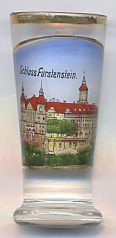

|
| POLSKA | POLAND |
| województwo: Dolnośląskie | voivodship: Lower Silesia |
| miasto na prawach powiatu: Wałbrzych | city: Wałbrzych |

 Książ castle (German: Schloss Fürstenstein) [left]
is located about 5 km north of Wałbrzych (Waldenburg).
It is the largest castle of Lower Silesia and the third-largest in all Poland.
Książ castle (German: Schloss Fürstenstein) [left]
is located about 5 km north of Wałbrzych (Waldenburg).
It is the largest castle of Lower Silesia and the third-largest in all Poland.
The castle was built in 1288–1292 in place of an older stronghold by Duke Bolko I of Świdnica (Schweidnitz)
and Jawor (Jauer). The early documents mention the castle under the names Wistenberch, Vorstinberech, Vorstinburg or
Fürstenberg; later it became known as Fürstenstein. The castle became one of the main seats of the duchy.
With the death in 1368 of the last male member of the Piast dynasty, the duchy came in possession of the Bohemian Crown
in 1392 where it remained until 1497. In 1509 the castle came in possess of the Hoberg (since 1714 Hochberg) family.
Between 1705 and 1742 the castle was rebuilt in representative Baroque style. Between 1907 and 1937 further two wings
were added in Renaissance revival style and the tower (47 m high) was toped with a domed roof.
In 1941 the family (since 1848 counts of the empire and princes, 1905 dukes, of Pless (Pszczyna))
was overindebted and was forced to hand over the castle to the German state.
During World War II, the castle was used to store the collections of the Royal Prussian Library.
After the war the castle was occupied by the Red Army. Between 1946 and 1948 it was the seat of the coal mining authority,
since 1971 it was used by the district centre for sports, tourism and recreation of Wałbrzych. Between
1986 and 1990 the castle was the seat of the voivodship centre for culture and arts "zamek Książ",
since 1991 it is owned by the municipality of Wałbrzych.
![[scale]](lineal.jpg)